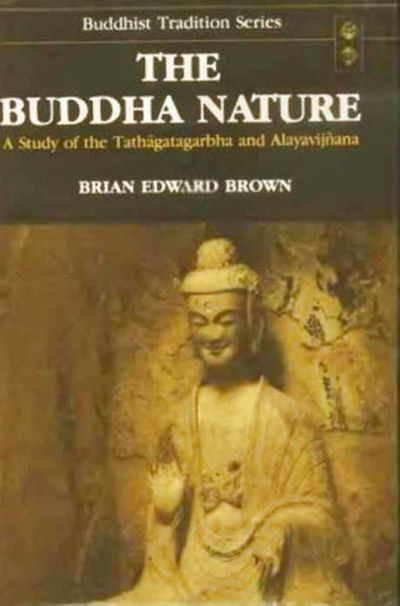The Buddha Nature: A Study of the Tathāgatagarbha and Ālayavijñāna
< Books
m (Saved using "Save and continue" button in form) |
|||
| Line 22: | Line 22: | ||
** {{i|The Nescience Entrenchment|20}} | ** {{i|The Nescience Entrenchment|20}} | ||
** {{i|The Buddha Natures|22}} | ** {{i|The Buddha Natures|22}} | ||
| + | ** {{i|The Four Noble Truths|25}} | ||
| + | ** {{i|''Tathāgatagarbha'' as Both ''Śūnya'' and ''Aśūnya''|31}} | ||
| + | ** {{i|''Tathāgatagarbha'' as Self-explicating Knowledge Evaluation|38}} | ||
| + | <br> | ||
| + | * {{i|II. The Ratnagotravibhāga|43-67}} | ||
| + | ** {{i|The Jewels of the ''Dharma'' and the ''Sangha''|47}} | ||
| + | ** {{i|''Samalā'' and ''Nirmalā Tathatā''|53}} | ||
| + | ** {{i|Threefold Meaning of the ''Tathaāgatagarbha''|55}} | ||
| + | ** {{i|The Meaning of ''Gotra''|59}} | ||
| + | <br> | ||
| + | * {{i|III. Characteristics of the Embryo Reality: Its Self-Nature|69-100}} | ||
| + | ** {{i|The Cause of the Embryo's Purification|70}} | ||
| + | ** {{i|The Four Supreme Virtues: Antidotal Methogology|72}} | ||
| + | ** {{i|''Ātma-Pāramitā'': Supreme Unity|81}} | ||
| + | ** {{i|''Nitya-Pāramitā'': Supreme Eternity|90}} | ||
| + | ** {{i|Supreme Bliss and Supreme Purity|95}} | ||
| + | ** {{i|The Result of the Embryo's Self-purification|98}} | ||
| + | ** {{i|The Union with the purifying Factors|99}} | ||
| + | <br> | ||
| + | * {{i|IV. Further Characteristics of the Embryo|101-123}} | ||
| + | ** {{i|The Function of the Embryo Towards Self-purification|101}} | ||
| + | ** {{i|The Embryo's Manifestation|104}} | ||
| + | ** {{i|''Cittaprakrti'': the Innate Mind|108}} | ||
| + | ** {{i|Buddhahood and ''Nirvāna''|118}} | ||
| + | <br> | ||
| + | * {{i|VI. Nine Illustrations of the GARBHA|125-134}} | ||
| + | ** {{i|Threefold Nature of the ''Tathāgatagarbha''|130}} | ||
| + | * {{i|VI. ''Tathāgatagarbha'' as ''Śūnyatā''|135-159}} | ||
| + | ** {{i|''Tathāgatagarbha'' as ''Śūnya'' and ''Aśūnya'',|141}} | ||
| + | ** {{i|The ''Ratnagotra'' and the ''Prajñapāramitā'' Tradition|150}} | ||
| + | <br> | ||
| + | * {{i|VII. The Properties of the Buddha|161-176}} | ||
| + | ** {{i|''Nirmalā Tathatā''|163}} | ||
| + | ** {{i|Evaluation|171}} | ||
| + | <br> | ||
| + | * {{i|Part Two|}} | ||
| + | * {{i|The ''Ālayalavijñāna'' in the ''Lankāvatāra Sūtra'' and the ''Ch'eng Wei-shih Lun''|}} | ||
| + | <br> | ||
| + | * {{i|VIII. The ''Lankāvatāra Sūtra''|179-194}} | ||
| + | ** {{i|The Union of the ''Tathāgatagarbha'' and the ''Ālayavijñana''|179}} | ||
| + | ** {{i|The Confusion of Epistemology and Ontology in the ''Lankaāvatāra''|185}} | ||
| + | <br> | ||
| + | * {{i|IX. The Ch'eng Wei-Shih Lun|195-211}} | ||
| + | ** {{i|The Metaphysics of Mere-Consciousness|195}} | ||
| + | ** {{i|The ''Ālayavijñana'' and the Bījas|202}} | ||
| + | <br> | ||
| + | * {{i|X. The ''Ālayavijñana'' and Ignorance|213-226}} | ||
| + | ** {{i|''Ātmagrāha'' and ''Dharmagrāha''|213}} | ||
| + | ** {{i|The "Manas'' and ''Manovijñāna''|214}} | ||
| + | ** {{i|The Ultimate Origin of Ignorance|223}} | ||
| + | <br> | ||
| + | * {{i|XI. The Holy Path of Attainment|227-244}} | ||
| + | ** {{i|The Stage of Moral Provisioning|227}} | ||
| + | ** {{i|The Stage of Intensified Effort|228}} | ||
| + | ** {{i|The Stage of Unimpeded Penetrating Understanding|230}} | ||
| + | ** {{i|The Stage of Exercising Cultivation|232}} | ||
| + | ** {{i|The Stage of Ultimate Realization|241}} | ||
|AddRelatedTab=No | |AddRelatedTab=No | ||
|PostStatus=Needs Copy Editing | |PostStatus=Needs Copy Editing | ||
}} | }} | ||
Revision as of 17:44, 26 March 2019
One of the fundamental tenets of Mahayana Buddhism animating and grounding the doctrine and discipline of its spiritual path, is the inherent potentiality of all animate beings to attain the supreme and perfect enlightenment of Buddhahood. This book examines the ontological presuppositions and the corresponding soteriological-epistemological principles that sustain and define such a theory. Within the field of Buddhist studies, such a work provides a comprehensive context in which to interpret the influence and major insights of the various Buddhist schools. Thus, the dynamics of the Buddha Nature, though non-thematic and implicit, is at the heart of Zen praxis, while it is a significant articulation in Kegon, Tendai, and Shingon thought. More specifically, the book seeks to establish a coherent metaphysics of absolute suchness (Tathatā), synthesizing the variant traditions of the Tathagata-embryo (Tathāgatagarbha) and the Storehouse Consciousness (Ālayavijñāna).
The book's contribution to the broader field of the History of Religions rests in its presentation and analysis of the Buddhist Enlightenment as the salvific-transformational moment in which Tathatā 'awakens' to itself, comes to perfect self-realization as the Absolute suchness of reality, in and through phenomenal human consciousness. The book is an interpretation of the Buddhist Path as the spontaneous self-emergence of 'embryonic' absolute knowledge as it comes to free itself from the concealments of adventitious defilements, and possess itself in fully self-explicitated self-consciousness as the 'Highest Truth' and unconditional nature of all existence; it does so only in the form of omniscient wisdom. (Source: Book jacket inside cover)
| Citation | Brown, Brian Edward. The Buddha Nature: A Study of the Tathāgatagarbha and Ālayavijñāna. Buddhist Tradition Series 11. Delhi: Motilal Banarsidass, 1991. https://archive.org/details/tathagatgarbhabuddhanatureastudyofthetathagatagarbhaandalayavijnanabrianedwardbr/mode/2up. |
|---|---|

